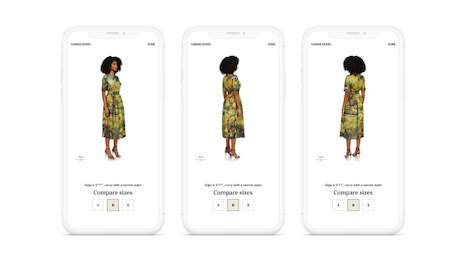By Meyar Sheik
With fewer places to see and be seen, the luxury business has faced tremendous challenges since the onset of the COVID-19 pandemic and the resulting shutdowns.
McKinsey & Company estimates a 35-39 percent contraction in the global luxury goods market in 2020 compared to 2019. Furthermore, it reported that as many as 80 percent of publicly listed fashion companies in North America could end the year in financial distress.
The tumultuous environment has caused many luxury brands to exit the industry, but that did not deter a different seller from entering the mix – Amazon.
With the official launch of the “Luxury Stores” platform Sept. 15, Amazon is now allowing its Prime customers to participate in the exclusive shopping experience from the comfort of their home (see story).
Amazon Prime customers will now be able to view items in 360-degree detail, and luxury retailers will be able to use Amazon’s merchandising tools to their discretion to best stock their online stores and price their items.
Initially, the test run will feature Oscar de la Renta’s pre-fall and fall/winter collections with more brands to join in the coming weeks.
While Amazon’s newest marketplace will help struggling luxury retailers approach the ecommerce audience without needing to develop their own interface, this launch has prompted discussion as to whether this latest move from Amazon is a lifeline for the industry or a competitive threat.
How to stand out in a new luxury format
Some luxury brands may choose to wait and see how Amazon’s Luxury Stores takes off after this week’s launch.
In the meantime, there are plenty of opportunities for brands to elevate their own ecommerce presence.
For those not ready to align with Amazon just yet, omnichannel personalization is the key to remaining competitive in this new landscape.
A recent study we conducted revealed that companies that leverage a personalization strategy across the entire customer lifecycle see higher ROI – 300 percent or more – and are able to quickly pivot to meet changing customer behaviors.
A major part of the luxury shopping experience is the level of connection.
When entering a traditional luxury store, the customer is given the white-glove treatment and made to feel as though she is receiving special services specifically curated to her needs.
With omnichannel personalization capabilities, luxury and fashion brands can help customers quickly discover the products they want with personalized search, tailored on-site navigation, personalized promotions and elegant look books, mimicking the top-notch customer service they received prior to COVID-19 in the physical stores.
First steps toward personalization, both in store and online
As luxury brands move toward a personalized environment, a simple first step could be delivering Web and email personalization based around product recommendations and customer preferences.
Next, content such as videos and blogs can be targeted based on geography, weather and day-parting patterns.
Personalization can occur on a variety of scales from broad mobile options to specific targeting fixated on the help center.
That being said, the majority of luxury shoppers still prefer to see and touch the high-priced item that they are considering for purchase.
Therefore, omnichannel personalization should extend to the bricks-and-mortar location by arming sales associates with tablets for clienteling and introducing kiosk and digital displays.
Customer identification can be implemented across the entire omnichannel process to streamline off-line and on-line interactions.
In a post-COVID era, luxury brands with physical stores will still have the edge over online pure-plays to the extent they can tie those shopping experiences together.
LUXURY BRANDS and retailers do not have to wait and see what Amazon does next. They can start delivering on customer expectations by starting with the easiest to implement personalization tactics and building up to a fully personalized omnichannel customer experience.
As the industry continues to evolve and consumer behaviors shift, providing personalized offerings consistent with the elevated in-person luxury shopping experience will set brands apart from the competition, even with Amazon in the mix.
Meyar Sheik is president and chief commerce officer of Kibo, San Diego. Reach him at [email protected].
{"ct":"d+lciAiqB\/ZaQojas72MqzkPByUP44J+kI8pqbkeB2c3T+s\/Bc7Oq3XaxpuhvyIHuaepBq7\/UQmbJUoCc4awIN7a+2ei4jXQ6uDVdAWkJzdPiVsm1otJqfkqXuq3589YCuCsGp+TSTnxvaCG8\/yLpklNGY5vc5T1P4yCmcEe8cz8bY2p3IqmHORV4BKCOGfq9LRNo256MRcJZMzCJP96PS4c3ut4iVcPDqNH53Wlawzujca+i02Ip+rY2h9fYMXAnsgoC\/nvpKfxL4W8E1A0pE9jYEpyFK7pq5+0wyt0l+9wUBGbPhHzkIJ8RO1y5+\/ydqI4CLozr7GUy4BqK7N0Ey6G8vqjscON60\/yOfR0zHgXJu4VkUVh3wp7RYIwnAe0fYfyiPYoP9f9MS9O\/cXo+3y2ewBFoh+k0opL0Jvc\/+o\/k32FMqf8G+oNgqMXIFIDoVBFdI2Q8Lg3aGRfDFeIAZ4cl80RFsnGEB9AAokAGMFPWqwRIhlBzE2hYaYEUf6GiG7uLViiLEfUP\/9KQhavXT\/HkRXB1GcBTumHttr1EQWJRRg006BWFnhYzLNae9ZiBEVAA9iVzDBbHiCGuEeWkKj4UHHitEHXNHq06pLSzx5gRN8bJMDxquchC3qpGJFNNegg7ukxRJi4xZS3KrK\/AyokDCMqsU+zRjH9n5xwDMaHaEDLiwlv5iShkW5e7ApiqmxHH\/WVbNXMXexPR1t+lDq8p3l7MAT+aUuumN4u4hYWtnyXr11zKMxgokRWkWFpGHOHixpl4GYtK+3O\/cNUsD1btLvbn\/Ip\/c1XW5nzh6tGthMfM+CI+NcBx2w0rWyUO\/Y3Ty8Uky+Z91VUSU9zvVIeIhSybY5Zn\/C0blVyiHudQsVql3DMFGX+bhzSHbVAKvstUoDQpqgRIzZ9CXMDWm+p8aFGb7s+aq7ozHuyJKzGVxL6IzucRMitn9HubGigo\/CF5behm\/aqKFKTMU+FIYTkH7E8A\/ZRla6vbBhus4+7FDmF104IKSpGYBCRckjxJ5VgKFSgA8TAnkU7RhKr0xMed54ptxmykUtpltJRXadNFPjE1CuK2osf7CGVe32G4plHqqHyts1iik9pB3vxi+HoSlSXE8xDOvhuH2qKal3fUZSM+S3\/PYKRMj\/xhVSK8iEfsBM5Zv2E7TtrGuCVYvBvMDICcQCmrmIQN9O75zbPHAhPgiCryPoHlte7FMnt3BOg9TWlRpaRmn4ZcYaOtLb9D5w+3siIhv5ZZG78Jeo0BhybDp7TheVXVHViUBTmAC7qOdnGlvoNoy4019VBatrzzSfKe6PLmPaxpD+FECs0sUfD13raqacv76hZrbQzbD7EHlm6eL1tKmUvxdZqLYe0JDARx2IJliHW4cIiObeIPIsg7dCB8MRyQYkBmdHHytlS0dBAtW2TPVxNVtaDrb4mfNSJYf4\/lF53goYmH5NGZhyyDGKFSBozBZ2mn\/sKLwN+B2LilxOnfgjz\/g6sureey9VNL8JNjxq2XroeJKruk82YQjc6VcBMGIli3URtxB5E35f5Ald5WigpjqlNvHjMa\/zYJa0BSU6CuIxuFQD3pJwEmg502sk2tc2XI\/UZICKnKZakkW0twKADNu3uo8RhtbU22csBwRmGnHeN248A\/5qlkSW9jgHaajK1P9XBWVhWbe2hUkPTwSTI\/ECd5qWIV+\/VI9dKrJ0v7dSw\/l7P+OBYGBD3cgG8FvOR9ibth2nHlxlSWm1H0zT4I0R7G6XV7s9jsnjaTsqHf\/gmYMOBj3sou4dZjFxpJWZln0kKNcTqtoro+gZhXFBB8neazBmWj3TAYfoAR++jH2YvNCapKk7q1l7FaIp50qJb8m9CHCx0df0f8otDWUwZzgJjpJ4FS\/npVk5a3lQmcOPwhLwHVDwrJ8a1CY6kBnot2uYIlLVDthfCB6XINZ8ZE50KqlQco\/QyiAAcXO8Z7OPoIL5tZJTPDjw7W4tLDmGkrRCbunVRTCg31kvCzUnYotyFhHUieV1qq+E6OYrqv66QIaNge8BNKUyK0Lfm3jnZYHyA\/6jvXCyiBsMWHilAu7yQBuZmtjKz0gVkpJjNB2j9q2gbE4sCqjqh9dwldtev4+IEo+zprBc6snnob+Q4WNeTcJG2AncNYI+cuopaRbYieOKPjhpoaf2sogKAXRK3SjKYTrzLyAMaD6\/5qwEu\/wWZqjabQSlEyUyPrhrrR9wYWT05YOTactb1cTsioBrydbDKOFOzZr0DSvj3pnjmMhpgH47A\/aTdCjxLWsXxJfo6Sm19WM9h4janL9No4GrSdO1Yju92bdadUgpXz63rqrI2y+Xkw++URM\/Xgwf3rMY7o8G+TkZBwqUnjQUzfBjn4e3XIEFs7Jq1lPjO4Lq1ABduB22vzAYYgrn0fzAqC5BxhAxtKu5AA4cg4S4PxW5RpgkaQ+gzz3QlhkyV4va3+3XcYQJU90IJ8eR1WexYxxhuPemjpiLu6PX1lM72QZWf7Uk5N+Wfu+1qHXsNS1y\/wAVmOQ5OjII2XHzV\/DXu+l3kSDT1wGN1yRZ5PWj1HKT4+ciGKvkogWpAHmSmVxuUvgvBLDe9ucJxQdk7fKuUdtcVelVfPJXRzBnHqOgm0DIEi7zk8+hpIe4bv4ZEJ74ry1BJrJaJofXL+01Z6XSbySn2n+fDCMg7yZF4WKcV6prWEQPeS6qX6RC4A2K4NSy25wyNKZfjJEmBD432YMgTHCaZxKg4ES3P\/PtmQNrCLx3uQ53XBcX4kUftLiK0e9t\/5GD112Rf9vJS4vGjBDhjFfKfXuzr8iygmO7GDwTeI2agmkHazJvobYTotu2\/GbJGRYO\/AVf1xRSmEtrScCgeNkFCnUIc454eRPziUx9WlecuI48wFTnyT2rVEeKe8Oz3+dR91kDiKFKZ\/lzfcmHZcqsI2mbKtYQQfjf2cFb+8jhUNQEI097DY81E2ygi8PR+vkrsE7sgElCjVTIHCeHjMsfz\/UCPor9lF8HBOMKs+SB4hRZ9hlogsO6Yy5WixJUak3IUXUNA1KxiETQVFIFumyDsg5x3k3a9fMA1wl8cse+oIu5O\/zd1G0KqFaStYpKmguholgzC6ccJ\/C7lU7eD9C5XDzvfdPK5nELYR7cHEs1QxEQF05cU9t\/1ltrmYpCBR6Y3JwYm+qZpuTFA77dPldAnD0HuwwuGH01\/96s1UNNFVURsEnIoAdU021uId9qJYPwLeMU9aDYrj6OYqKAVVQ9JTYhOlvpuZQqSVQNRagwKFvOST9o1ihJyQxG59RBgLbXEiCZ3eJh\/hjrhjDE5JojEmap\/j7243Z3RBHZ3bim+xra2vL2s2GEpwTyhjDXWWIK8JWv\/uXW5DoSZLuVObTYwen4fn5fbAVxXvSi6RWZkIekwDD1WzB3aIFGG0ZlozMPcfPlMcpEm7BouiCosqhsKEcdWB4grwvY8Qvma+wA3jpHT50UcJLMUaIvrs6BOc\/R5FBVF6Cqi04Kvapxc2i7yNr08fNHs002NBM3sr\/9M81AdZr9\/cbBCWloJ9qSS1prlPr1pNDMMDf75H2SA3+ZcJIusccSHNoic08dNP\/iwPh7AK8DLHVd0GS4\/dCtm2BN92hCj6lhjJ\/D4uYXKWaPEqQ58BjoZgTYp+gDrnDyBtDnBL7FLOMVVNzRFLXM\/GzwKeElx9UIzZA1chVxYu6l1C0FYph4k1IuhODNEzoNIEhIlTEd1bLQXGTuOucAFr4H9ViQXL3BFblaUgYSy1xR3Gdyz4NZYC2hbSIuFo2tMduH3PNU1N\/duFKvRdud2s6IlS2gHAhTJVivThNQqCN3ygv0O\/KnIQlUJg9Dp9XiIzigDpG9+f8LSE1LQsSbtqbGuKAOQXsLafHidTP1K87Hhfb\/LhK8+aXl5BUv709LwyCGGW+C4hNUwDwUlGwwRuxdROgZrvhiyQSFhMgCjFy0HIBdKscmVoNdUkGnCx3gntxSNqMCJAT4d5Ydp\/9lsRn\/fGXlSoJwEMxn8ARoDYMbRNQ6a3VJGVzCSdZEfPsNHq+AR1p2sppUMdd4HcZiE92vK9oPGWCgnwYKROOIFupdwvIWMH\/Dke7E0hFzBamNDapnCUNZ1Mec4goQIM1QE1dkKP4lYTOj2A3wP4xsvmqXalLk7ZehKHsO7PE1mZoINONP4A1xGnEpMqmfpomV9GMl+FqTQDGMqb2JjvicYxD4lNHz5T0N4aogfSnsiLM7UurbvpslHhdgxEeLkk8xq+fkTedtLITixYUWxAM+Dn\/\/Ahb0oJR25TFz85n6oq0uxutAud67EK7iE3y+dx2kRZ5IAMX+ZfWOgvh3lr+HeYI1ri9s7gj9T4RCcbTgXY2Sf7qqnH3VVkjR4PGRjvqik7VLe2vasyFYXF1223xugdC\/bdlFhdTXQADjRxiYbrb+MuZbVQ2fJH7fQGesPrGtWE3YxOK6tEGaQCJtSI9jKEu6UQyT7ZgvLVM6DyHxNwjEkLl5Jr0B8t9QItmc0F5sg9uWT4yBrI5e2zS5XZVbPy06vyiChkXFL3VXwypYvHtOQxjUKSePETo74fZAvhTuH5vQl1D9f3nyqF5SFP5Czs0J+hsvkiyaM4g9ewRvC+MqogCtvIXjML6TgRNwUccUtLUxZDdkO7S8Xf28C1k9ea2WwUM23nN9qd09xSattWcSgUHOuDpEAKrqmWRToJtTkZby2fbtpD2S4Ayd7fD6wPGzwVeWMiy\/Pykk4Txwp1kz99iVhzEpy2UhqXsehrmCl7dxaOzJ2uPY7BM6g2hSGgX9GBiy10FFMc5pp9pFVrTvess42ADnKo\/YxSLbvrK0pW7dF3qVzhrbHK6S26ZEUFORiS1S9OI7AzEakAgD5xdglX7bY5MeuWARZSeqU8aynS1sJOs0WMD38ohd31LH3wv9Yhxmzw0+7pLsXfidf0JLa9lQ3p8pNSp0RIX5DhscK4MZJ8kXwEhgW7aqCtLQZRWsJ3gFDRZTLPNrP9c5QeCuuQNdPIlaT6dL\/gfXOIeFOVyB+CU4DfBSl9SPyKZ98mQr336dqtQvcCpF9pDyf\/vX6+bjucDrkqPtukzWR5iwNI3zqeuSOHZyjoVMKC4rT5WWiKhZ1f3gWc3wFGYFff4frX7VnatS5deTVY\/QHRxM96kcQ9L3q14CoR2KDia7+doY9BX4YA7autaBruhbrSNq+Oy3phO0yK1PoLYhn+eNnDkEOl1joxsJ\/90qDmUes9w4fTw9NaM51vms9BDgZiyHTmdxxot\/bgtlfWmadX9rr5G\/Kiw\/UUyz4qcXGvGatCIZISDrS+Zi5jedfS1ttNtmY0TW+H09GO0XudI5YJmSrixYT5r3HLfUxtia8EsCIEptmkpG3o9b1SCfrX7XuKWnbGhpctRzn3MNHbcI1UvDL12sqJ5BEi7f7\/tiYv3umzu85QJaDwqNhgOLtk9YqExReJ5f66Ahp8YTt6fFEg+mnZR0n+YH8U3POtsF6F\/dEDBucSqXCfE9H6LHffcd+VrUMaHXngSAtbIeWtY+\/oguHWrmQfpSOFn7kmqIKLS9CgOT455zBYcJxd\/OuMbEfupmhMIDA0382XiYdYn\/n\/HZq0zK8EC\/ehC9ex1OJv691iK9pso4VmwI3DqnMtfZRJm7+iDyd8bslHq\/TneKY0eQov3vMd5aRI1U9W0b2CXa4O8OqAAISeTl+Jvr95CrFcytA8OeUjZA48ptPkH08tQT1hQwYNYazWeamTMSIkquUJlSY6QIZC0ccRkU\/VL\/+yutQpXsoT3JNsC4GKVcFiDmQQAnYOzIL+4NVcAJe\/Ak5+7+p5ytxIXieiuyOt5LB\/5z69TjDAhm0FXrPLFb2tr0iJJu8hHgiipQc3tQh6eWuuaGpddHGRlvMulAGBX5oimbpeiBzszlUV24alkJXjwHfp+E388nLCwk5NxGcA0ovNchJboJwgHxEABtnnBEDdWGR3wZcWeI8dNQwC2fVjAU8GwL7efvNv1yByVFYd\/lK4PJcoZjd0U57cQNUx6\/XE9223Ty7z8dv+b4Y6DKIcAQcoAMSjLktp7FH6Rub6M8WR68Kg9X25fuVaxYdAoNMxwFRn2ism6GkhxKskoY1lgyClFRpslq9X8l4hexrl6IalYTOq3clA\/sOYEZjXMdIwls\/D2q4snmXbLnVGhGHXlYRfq6rauFFQS1YL2NrRgDhNjiCmIcRQel5ez8pnIBaegoz2ajsfQecHeRFWC73f4PCY6c6UONWEoV\/04M7aWWjfDD8AT\/VEYaorYkDprm14pOPzeE1cogI6Sz4IC2uzfv+fImDzD8XKAn29MjBGbq2d1GYetG3plMtqwCLZ8q6nFJL4zUWcSneCYgzoWj+iaFREqWGETUFiFobs9RkuZY7iJCfM+TxPzl3mIzIiizg+e6R9zJs1kWtv8yXPbw9BMKzZ6dfWdSSjrTSy4V+xn3n2Emppl7\/CaZNlIwdHl\/61lLRPpGncbjkBEngUTke8zeYlRINXOmEjO\/BNylg7m1lCO2+bIwrrhQA+N9+fAXMePN\/2jECZNtvwipbnD22cCkE4oowWqsizJcMqyzloKRyQzB+0jIhGGUAa+LvddCeR8v3DXHykmf2BUttlHD91ovJ80ojKr2nG2Z74+k7eZ32ZihbeJLp+plYuvn1Beg5vIN39HkkwoGvKdx3HOEFi0xCXJEQK3xsRHQYm0CNwc3GWmmvtCvhBDhK+7jO0EnlVG0PKrWwmDlPSFIm9qtzwy\/558ugtEwZrYsT0mJCLFOxG5phV1zKLIIYb0FNUfpcA2tjATD11SvS5c8zJcsaIhH4rY6m7A2hiY21Zr29O\/7RdxtzJ\/rUmJSgAPva4mor9zfS2xfx0ZdVfkBMRV7iAFDYT3rm0ge7mpehkNipd8FCxgZfXQDvdGni5GKVyAYUpVf6Z\/GpT143ZdctPrJS1p8JzrpFaq8AlWpunNt0Rz4\/ihyyBjVE5fxu9qEU31I9jEv1zjs0P8Or3yevVkmHPWCyRPajVZBZuudfAlTnBauPZrm+\/6K6u6baFmCarWniSrUHMr8f5bsL2TMaCeYfZNCIFOo6X98i\/6SNN7OpyYhO\/I9gNZljYd0D5o03U3Gom15rqad3uYSKNF3C5ft3BwZTFtwZm9jaVxopbp9U12mz3nJ4NaLEVhv0PBV9Bcemmjbm8U5U52oIHtLo86A4H04j5oVfuZuK3C6EIhjrQg\/+dUMSlzy8PTVFXDZnItWycln4612Ckifea2bHT+LTPg5\/hrShsGhWmJvAbbQr7gOc\/Nw6RLSwCD1OoJu73zgQc1y7hpkf","iv":"3765db29a2c0e7dffa73dc53c4b51049","s":"7131c8ceba00f739"}

 Amazon's Luxury Stores is launching with Oscar de la Renta to select Prime customers. Image credit: Amazon
Amazon's Luxury Stores is launching with Oscar de la Renta to select Prime customers. Image credit: Amazon